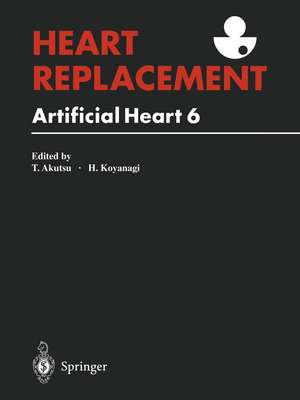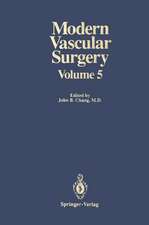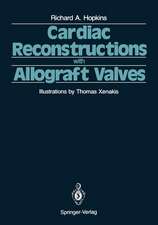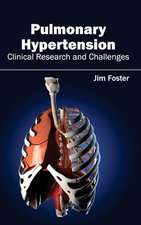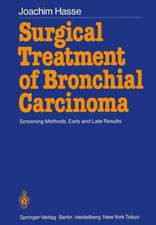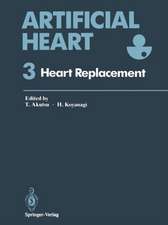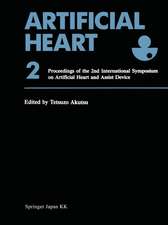Heart Replacement: Artificial Heart 6
Editat de Tetsuzo Akutsu, Hitoshi Koyanagien Limba Engleză Paperback – 19 apr 2014
| Toate formatele și edițiile | Preț | Express |
|---|---|---|
| Paperback (2) | 400.56 lei 6-8 săpt. | |
| Springer – 19 apr 2014 | 400.56 lei 6-8 săpt. | |
| Springer – 2 oct 2013 | 739.13 lei 6-8 săpt. |
Preț: 400.56 lei
Preț vechi: 421.65 lei
-5% Nou
Puncte Express: 601
Preț estimativ în valută:
76.64€ • 80.03$ • 63.29£
76.64€ • 80.03$ • 63.29£
Carte tipărită la comandă
Livrare economică 15-29 aprilie
Preluare comenzi: 021 569.72.76
Specificații
ISBN-13: 9784431659235
ISBN-10: 4431659234
Pagini: 524
Ilustrații: XX, 524 p. 456 illus., 6 illus. in color.
Dimensiuni: 210 x 279 x 32 mm
Greutate: 1.21 kg
Ediția:Softcover reprint of the original 1st ed. 1998
Editura: Springer
Colecția Springer
Locul publicării:Tokyo, Japan
ISBN-10: 4431659234
Pagini: 524
Ilustrații: XX, 524 p. 456 illus., 6 illus. in color.
Dimensiuni: 210 x 279 x 32 mm
Greutate: 1.21 kg
Ediția:Softcover reprint of the original 1st ed. 1998
Editura: Springer
Colecția Springer
Locul publicării:Tokyo, Japan
Public țintă
ResearchDescriere
The 6th International Symposium on Artificial Heart and Assist Devices met in Tokyo in July 1996, bringing together researchers and specialists from around the world. The symposiums proceedings in this volume comprise papers from nine sessions, each opening with contributions by leading scientists: TAH, heart transplantation, biomaterials, VAS, clinical application, pathophysiology, engineering, new approaches, and special sessions. Of special note is the inclusion, for the first time, of pathophysiology related to clinical use of assist devices. The clinical application section includes a paper by Dr. Michael DeBakey on the progress made in recent years. With descriptions of the scientific exhibition, accompanied by photographs of all artificial heart devices and systems displayed by major laboratories and manufacturers, Artificial Heart 6 presents the latest information on developments in the field of artificial heart, biomaterials, and heart transplantation.
Cuprins
I Total Artificial Heart.- Prospects for Implantable Circulatory Support.- Implantable Devices.- Ultracompact, High-Performance, Completely Implantable Permanent Electromechanical Total Artificial Heart.- Development of a Totally Implantable Intrathoracic Ventricular Assist Device.- Use of an Improved Linear Motor-Driven Total Artificial Heart in an Acute Animal Experiment.- Artificial Heart with a Highly Efficient and Sensorless Fuzzy-Controlled Energy Converter.- Basic Research.- Over 500 Days’ Survival of a Goat with a Total Artificial Heart with 1/R Control.- Heat Dissipation from Artificial Hearts: Characterizing Tissue Responses and Defining Safe Levels.- Brain and Spinal Cord Lesions with Long-Term Total Artificial Heart Pumping.- An Adaptive Cardiac Output Control for the Total Artificial Heart Using a Self-Tuning Proportional-Integral-Derivative (PID) Controller.- Acoustical Characteristics of a Moving Actuator Type Total Artificial Heart.- Vortex Blood Pump.- II Heart Transplantation.- Bridging for Heart Transplantation by Different Types of Ventricular Assist Device.- Mechanisms of Exercise Response in Denervated Heart After Transplant.- What Will Happen to Permanent Left Ventricular Assist Device Recipients? Clues from Long-Term Outcomes of Heterotopic Heart Transplants.- III Biomaterials.- Biomaterials: Facts and Fiction.- Blood Compatibility.- Calcification and Thrombus Formation on Polymer Surfaces of an Artificial Heart.- Surface Modification Techniques for the Artificial Heart.- Durability of Endothelial Cell Monolayers Inside a Beating Cardiac Prosthesis.- Evaluation of a Newly Developed, Heparin-Bonded Artificial Lung in Chronic Animal Experiments.- Device-Related Problems.- Alumina Ceramic and Polyethylene: Materials for the Double Pivot Bearing System of an Implantable Centrifugal Ventricular Assist Device.- Highly Blood-Compatible Surface Consisting of a Silicon-Containing Block Copolymer with Supramolecular Structure.- Development of a Fracture and Wear-Resistant Titanium Graphite Composite.- Influence of Microporous Structures on Mural Thrombosis and Endothelialization at Blood-Contacting Surfaces.- IV Ventricular Assist Devices.- The HeartMate Left Ventricular Assist System: Looking into the Future.- The Jarvik 2000 Oxford System. Prospects for the Future.- V Clinical Application.- Ventricular Assist Systems: Clinical Application.- Clinical Application 1.- International Paediatric Ventricular Assist Device Registry.- The UCLA Experience with Assist Devices as a Bridge to Transplantation in End-Stage Heart Failure.- Medically Unresponsive Pulmonary Hypertension: Heterotopic Cardiac Transplant Versus Mechanical Support.- First Experience of Novacor Implant at the Heart Institute of Japan.- Application of Wearable Novacor Left Ventricular Assist System for Patients with End-Stage Cardiomyopathy: Osaka Experience.- Clinical Application 2.- Ventricular Circulatory Support with the Abiomed System as a Bridge to Heart Transplantation.- Bridging to Cardiac Transplantation with the Thoratec Ventricular Assist Device in Australia.- Patient Selection for Successful Outcome with the CardioWest Total Artificial Heart as a Bridge to Heart Transplantation.- Bridge for Transplantation with the Symbion and Cardiowest Total Artificial Heart: The Pitie Experience.- Muscle Pumps.- The Effect of Cardiomyoplasty on Coronary Blood Flow and Diastolic Dimension of the Left Ventricle.- What Is the Ideal Frequency for Skeletal Muscle Ventricle Electrical Stimulation?.- Muscle Blood Pump Driven by Roller Screw Linear Actuator.- Circulatory Assistance Using Linear Skeletal Muscle Ventricle.- VI Pathophysiology.- Mechanoenergetics of Natural Hearts: Contractility, Mechanical Energy, Oxygen Consumption, and Efficiency.- Treatment of Idiopathic Dilated Cardiomyopathy (Beta-Cardiomyopathy) by Insertion of a Left Ventricular Mechanical Support System.- Altered Hemodynamic, Humoral, and Metabolic Conditions in Nonpulsatile Systemic Circulation.- Influence of Long-Term Support upon the Severely Failing Left Ventricle.- Sympathetic Nerve Adjustment to Artificial Circulation.- Pathological Study of a Goat That Survived for 532 Days with a Total Artificial Heart Using the 1/R Control Method.- The Role of Pulsatility in End-Organ Microcirculation After Cardiogenic Shock.- A New Index for Characterizing Pulsatility: Recovery of Renal Function.- VII Engineering.- Further Development of the Moving-Actuator Type Total Artificial Heart.- The “Cool Seal” Concept: A Low-Temperature Mechanical Seal with Recirculating Purge System for Rotary Blood Pumps.- Remote Energy Transmission for Powering Artificial Hearts and Assist Devices.- New Insight into the Fracture and Wear Problems of a Mechanical Heart Valve — In Vitro Microstrain, Creep Rupture, and Wear Studies.- Basic Study Towards the Establishment of a Fabrication Technology for a Vacuum-Formed Blood Pump.- VIII New Approaches.- A Review and Assessment of Investigative Methods for Mechanically Induced Blood Trauma: Special Aspects in Rotary Blood Pumps.- Remote Monitoring and Control of Artificial Hearts and Assist Devices.- Fractal Dimension Analysis of Heart Rate Variability with Left Ventricular Assist Device.- Parameter Optimization Approach to Estimation of Emax Under Cardiac Assistance.- Development and Clinical Application of Silicon-Coated Leak-Free Oxygenator with a Built-in Hemoconcentration Function.- IX From Pulsatile to Nonpulsatile.- Magnetically Suspended Centrifugal Pump as an Implantable Ventricular Assist System.- In Vivo Evaluation of an Intraventricular Axial Flow Blood Pump.- Improvements in the Design of the Monopivot Magnetic-Suspension Blood Pump.- The DeBakey/NASA Axial Flow Ventricular Assist Device.- X Posters.- The Design of a Linear Oscillatory Actuator for an Artificial Heart.- Reintroduction of the Jarvik/CardioWest Total Artificial Heart as a Bridge to Transplant.- Application of Adaptive Pole Assignment Method to Vascular Resistance-Based Control for Total Artificial Heart.- Relationship Between Atrial Pressures and the Interventricular Pressure in the Moving Actuator Type Total Artificial Heart.- Progress in Developing a Permanent Totally Implantable Pulsatile Impeller Total Artificial Heart.- The Combined Use of Extra-Aortic Balloon Counterpulsation and a Ventricular Assist Cup for Acute Heart Failure in Dogs — Effects on Regional Blood Flow.- Implantable Rotary Blood Pump Performs as Well as Pulsatile Pneumatic Assist Device.- Implantation of a Ventricular Assist Device in Animals: Progress and Regress.- Ventricular Assist Device Made with Silicone Valves and Silicone Blood Chamber.- Evaluation of Pump Performance of a Percutaneous-Type Pulsatile Left Ventricular Assist Device (MAD Type 5 and Type 6).- Automatic Regulation of Output of an Electrohydraulic Left Ventricular Assist Device Using the Polymer Bellows Water Pressure and Motor Current.- Scintigraphic Analysis of Cell Adhesion in Oxygenators and Internal Organs.- Surface Fixation of Lumbrokinase via Photochemical Reaction of Azidophenyl Group.- The Effect of Lumbrokinase, a Trypsin-Like Enzyme from Lumbricus rubellus, on Human Blood Cells.- Multivariate Analysis of Key Factors in Clinical Results of Postcardiotomy Circulatory Support.- Clinical Experience with Percutaneous Cardiopulmonary in Postcardiotomy Cardiogenic Shock.- Feasibility of Ferromagnetic Artificial Cells for Artificial Circulation.- Arterial Resonance Inferred from Analysis of Arterial Impedance.- Artificial Heart Flow Visualization Tests — A Comparative Study of Different Valves, Ventricle Geometries, and Control Parameters.- Successful Dynamic Cardiomyoplasty with Pharmaceutical Support.- Scientific Exhibitions.- Key Word Index.
